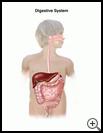
Hirschsprung Disease
________________________________________________________________________
KEY POINTS
- Hirschsprung disease is an illness that children are born with that prevents them from having a normal bowel movement because some of the nerves in the bowel are missing.
- Your child will have surgery to remove the part of the intestine that has no nerve cells. The healthy part of the intestine is then connected to your child’s anus.
- Your child’s healthcare providers will teach you how to care for your child at home. Ask what symptoms or problems you should watch for and what to do if your child has them.
________________________________________________________________________
What is Hirschsprung disease?
Hirschsprung disease is an illness that children are born with that prevents them from having a normal bowel movement.
Squeezing of the muscles, which is triggered by nerves in the gut, helps move digested food through the intestines. Hirschsprung disease is a problem that happens when some of the nerves are missing. Without the nerves, the muscles cannot move digested food through the intestine, so the intestine gets blocked. This can make it hard for your child to pass bowel movements (constipation).
Hirschsprung disease may affect only the area near your child’s rectum, or it may affect a larger section of the large intestine (colon).
What is the cause?
Before birth, a child’s nerve cells normally grow along the intestines toward the anus. When a child has Hirschsprung disease, the nerve cells stop growing too soon. The reason for this is not known.
Sometimes Hirschsprung is inherited, which means that it’s passed from parents to children through their genes. Genes are inside each cell of the body. They contain the information that tells your body how to develop and work. This disease affects boys more often than girls.
What are the symptoms?
The symptoms depend on how much of the intestine is involved. Symptoms may include:
- Not being able to have a bowel movement within a few days after birth
- Bowel movements that are long and skinny like string or spaghetti
- Vomiting
- Passing a lot of gas
- Swollen belly
- Diarrhea, which may be forceful
- Poor growth and trouble gaining weight because this disease can keep nutrients from being absorbed by the body
If your child has a mild case of Hirschsprung’s, symptoms may not start until your child is older. In addition to some of the symptoms listed above, older children may have constipation that gets worse over time.
How is it diagnosed?
Your child’s healthcare provider will ask about your child’s symptoms and medical history and examine your child. Tests may include the following:
- Rectal exam, which your child’s provider does by gently putting a lubricated and gloved finger in your child’s rectum to check the intestines
- X-ray of the belly to show the general size and shape of the intestines and to check for constipation
- A barium enema is an X-ray taken of the belly after barium is inserted through the rectum to show the lining of the walls of the large intestine (colon) and rectum and any abnormal areas. Barium is a chalky white liquid that coats your child’s digestive tract and shows up well on the X-ray.
- Tests to check the strength of the anal and rectal muscles
- A rectal biopsy, which is the removal of a small sample of tissue from the rectum for testing
How is it treated?
Hirschsprung disease is treated with surgery to remove the part of the intestine that has no nerve cells. The healthy part of the intestine is then connected to your child’s anus. The anus is the opening of the rectum where bowel movements leave the body.
If your child is very sick at the time of diagnosis, your child may need a procedure called an ileostomy or colostomy. These procedures are done to connect the healthy part of your child’s intestine to a new opening in the belly called a stoma. Your child’s bowel movements will empty through the opening and collect in a disposable bag outside the body. These may need to remain in place for a few months to a year. After your child heals, a second procedure may be done to connect the healthy intestine to the anus. The stoma will be closed during this procedure.
How can I take care of my child?
Your child’s surgeon and nurses will teach you how to care for your child. After surgery, you will need to care for your child’s incision area. If your child has a stoma, you will also learn how to care for it. To help prevent an infection and other problems, follow your healthcare provider’s directions carefully.
Follow the full course of treatment prescribed by your child’s provider. Ask your provider:
- How and when you will get your child’s test results
- How long it will take for your child to recover
- If there are activities your child should avoid and when your child can return to normal activities
- How to take care of your child at home
- What symptoms or problems you should watch for and what to do if your child has them
Make sure you know when your child should come back for a checkup. Keep all appointments for provider visits or tests.
Last modified: 2021-12-07
Last reviewed: 2019-09-13

